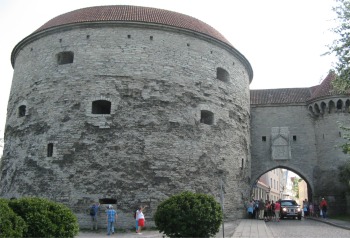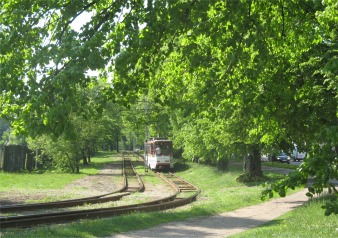Departure day! Rex, Dan and I hiked to a supermarket for last minute provisions, while Alan stayed behind to get the latest wind forecasts, and also to try and pay for our stay at the marina. A 13:00 slot with the customs to extricate ourselves from the country meant we had to leave the marina by 11:00. However, we still hadn't identified who we would have to pay the marina fees to.
Time was running out, and Alan spent about an hour trying to explain to the clubhouse that we needed to be away by 11:00, and thus we needed to make payments immediately. He went around an endless loop with the guys in the clubhouse who in turn nattered away in Russian amongst themselves before responding to Alan with, "Later". Poor Alan reiterated our need to leave imminently. Eventually a girl was pulled in who spoke a little English, and the penny dropped, leading to debates about how much we should be charged. Once a figure was agreed, Alan tried to pay by card, but they had no terminal to accept it. In the end, they frog-marched Alan to an ATM machine and the problem was resolved.
We said our farewells to Dan who had really enjoyed himself. He stayed behind at the marina to photograph us as we departed. We glided out across the water under a glorious blue sky, and I was quite moved as we waved to each other before our vessel disappeared behind a sea of masts.
We motored across to the customs point, passing fishermen in rowing boats, slowly pulling their nets in, seemingly suspended in space and time.
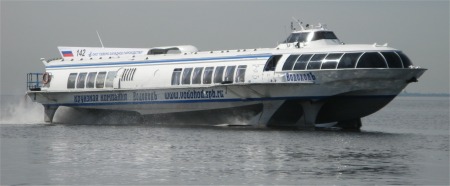 High Speed St Petersburg River Ferry |
The leg out to Kronstadt was under motor, and there we had a chance to see the new swing bridge being built there. This was an enormous feat of engineering, the part that swung out resembled half a ship and clearly floated. It was attached at its pivotal point by an enormous ball and socket mechanism.
Right on cue, as soon as we passed the swing bridge we received a call from the Russian coastguard, who had been tracking our every movement since leaving customs. The girl checked we were sailing to Tallinn and then said "Goodbye" - how sweet. Vladimir had assured us that they would continue to track us until we were well clear of Russian waters.
Once past Kronstadt, we set the sails and lazily drifted between two large anchorage areas full of tankers. Meanwhile, Dan sent me a text telling me that he had successfully negotiated his way out of the country and had now landed at Heathrow. The extra documentation he had acquired in order to leave the country had not been inspected at all.
28th May
I took the early 3 - 6am watch, usually a wonderful display of pinks and blues as the sun rose, but this morning it was a cold metallic introduction to the day with showers. We kept our vessel 200 - 400 m outside the shipping lane to avoid the packs of commercial traffic whizzing by. Alan had observed that the large ships never seemed to alter speed in order to avoid other vessels, they just altered course slightly. They also tended to move in packs.
On my midday watch, the boat was enveloped in thick fog, a real pea-souper. I had one minor scare when a ship, that I was tracking on radar and AIS, decided to change course in order to enter a different set of shipping lanes, and there was a strong possibility of a collision. Fortunately he had spotted us on radar, and altered course to pass behind us, giving a long single blast of his horn to advise us of his intentions.
Another huge vessel slowly appeared out of the mist, accompanied by a group of auxiliary vessels. Judging by the monstrous crane on its stern and the multiple hawsers disappearing into the cold icy depths, it must have been on a salvage operation.
We ploughed on through lumpy seas and heavy hail storms.
29th May
I was up at the crack of dawn, but the glowing red sun was hidden by a bank of clouds to the east. Alan advised that the water tank was almost dry. He tried the contents of one of the three spare water containers we had stowed near the bow, but the taste was noticeably plastic flavoured. We only had eight more hours to go before reaching Tallinn.
 Approaching Tallinn |
30th May
 St Olav's Church |
 House in Pirita |
Once the washing was taken care of, we took a bus for the 5km journey into Tallinn city. Residing in the Gulf of Finland, Tallinn is the capital of Estonia. With its web of winding cobblestone streets, which developed in the 11th to 15th centuries, it is one of the most completely preserved medieval cities in Europe; a precious city on the UNESCO World Heritage List. Once a medieval Hanseatic town, it became a pawn in the geopolitical games of its big neighbours, passing into Swedish hands in 1561 and then to Russia under Peter the Great in 1710. By World War I, Estonia briefly gained independence. The country was eventually occupied by the Soviet Union in 1940, only to be conquered by Nazi Germany (1941-44) and then retaken by the Soviets. In World War II, the city was quite extensively bombed by the Soviets, yet despite this the medieval town remains through careful restoration. The Soviet Union undertook a program of massive Slavic migration, and just over 40% of Tallinn's current inhabitants are Slavic (compared to an average of 28% for the entire country). On Aug 20, 1991, Estonia declared independence and Tallinn became its capital once again. Tallinn today contains lots of influence from those days, but still manages to retain an Estonian soul and identity. This is not a huge capital, the population of Tallinn is just over 400,000, but it has it all; a very rich cultural and pleasant atmosphere.
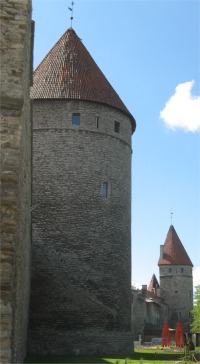 Defence Towers |
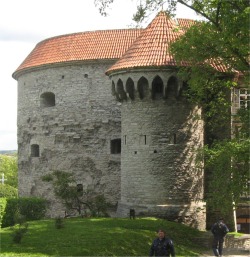 Wilfarditagine Torn |
We walked down cobbled streets with scarcely any traffic to concern ourselves with, and made our way past St Olav's Church. This 13th century church was the tallest building in the world between 1549-1625. But the 159m spire was also an effective lightening rod, and had been hit repeatably, completely burning down the structure three times.
Our route took us down to the maritime museum next to Fat Margaret's Tower, only to find it closed. A plaque outside honoured the British sailors who helped Estonia reach its independence in the early 20th century.
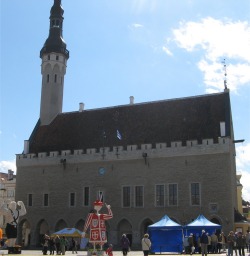 Old City Town Hall |
 St Catherine's Passage |
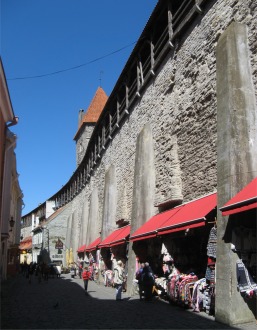 Muurivahe |
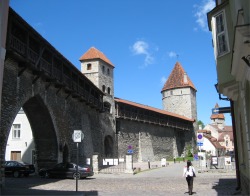 A City Gate |
 Toompea Castle |
 Alexander Nevsky Cathedral |
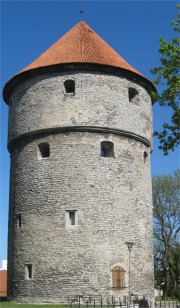 Kiek-in-de-Kok Tower |
Dropping back down to the Town Hall Square again, we passed the Kiek-in-de-Kok, "peek-into-the-kitchen", Cannon Tower. It got its name from its location overlooking the town, so tower guards could "peek" into the windows of the houses in lower Tallinn. Kiek-in-de-Kok housed the Tallinn medieval museum. As we dropped back into the cobbled streets, hoards of fun runners were passing us in the now stiffling heat, no doubt raising funs for good causes.
The cafes in the square beckoned us, so we sat in the sunshine and enjoyed a coffee and people watched - that was all we could do since we couldn't understand a word they spoke. The folk in the square, a mixture of local and tourists, were all laid back and full of bon homie. This was a charming old town, full of vigour and young life, with the youth providing all the entertainment on the stage.
Exhausted, we made our way back to the boat and had an excellent meal at a restaurant at the complex. It was Rex's last night with us as he was returning to his wife and normality the following morning.
31st May
 Pirita Convent |
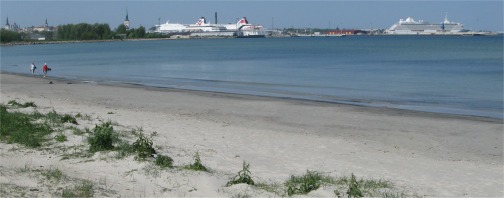 Tallinna Laht |
We all shared fond farewells over breakfast; more like uppercut banter really, and I escorted Rex to his taxi and waved him off. He would be missed on the boat; a stout hearted, easy going soul, always with a smile on his face and full of banter. He acted as a gel for us all.
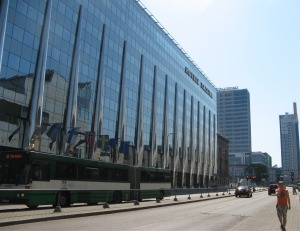 Modern Tallinn |
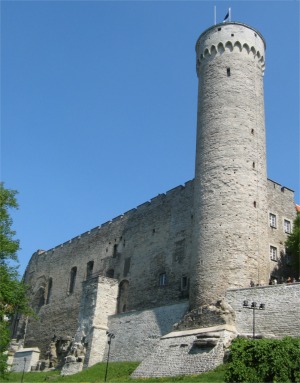 Tall Hermann's Tower |
He excused me for continuing to explore Tallinn, and I made my way across the Pirita River which runs into the marina, and over the way to the Pirita Convent Ruin Park. Pirita derives its name from the Swedish name Birgitta, which is the origin of the anglisised form Bridget. St. Bridget's Convent was founded there at the beginning of the 15th century and operated for about 150 years. In January 1575, the Russian army destroyed the convent and took the nuns prisoner. Two years later, they returned for more thorough devastation. After that the ruins were temporarily used as a refuge and a neighbourhood quarry. Not until 400 years later, in 1980, was the Ruins Park of the medieval monastery opened, and in 2001, the new Pirita Convent was consecrated.
Since it was such a lovely day, I hiked all the way into town along the beautiful sweeping Tallinna Laht with its sandy beaches, busy with walkers, joggers, cyclists and skaters. I entered the new town purely to buy a new phone, my existing one being almost useless by now. Texts were getting garbled and one message even ended up at the wrong number.
Once semi-up-to-date with technology, I headed up to the Toompea Castle again to get a view from the old battlements angle, and take in the Tall Hermann's Tower. At 48m, the "pikk hermann" was the tallest defensive tower on the Tallinn city wall.


